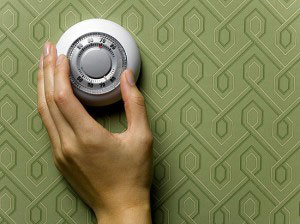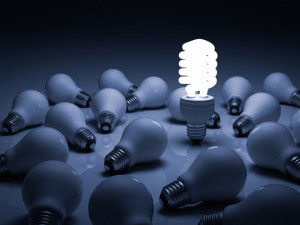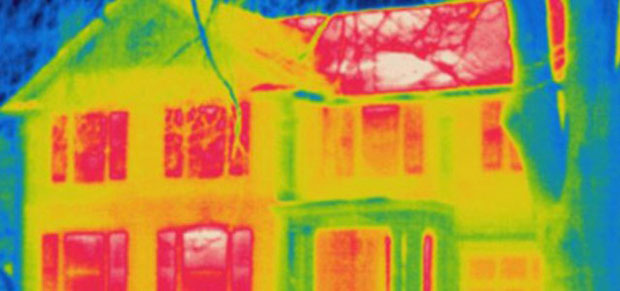As temperatures are getting lower and lower, for some of us at least, we might feel the urge to turn on the heat sky-high. But at the same time, we are getting depressed when watching our hard earned money disappearing from our pockets, because along with the heat we are also burning dollars.
There are other ways to keep you and your family warm as the temperatures drop without breaking the bank. Here are some winter time energy saving tips for you folks, because each and every one of you can cut costs on your energy bill in just a few easy steps.
The first step might seem obvious: take advantage of the heat generated from the sun by letting it naturally warm your house when possible. You should open the curtains during the day on your south-facing windows when the sun is shining and close them during the night; this will actually help you conserve the heat, especially if you have thick fabric curtains.
Sealing the leaks
You should take care of drafty windows (and doors by the way), by insulating them during the cold winter months. You can use various materials, from silicone foam to clear plastic sheet on the inside of the window frame, sealing it tightly and stopping the loss of heat.
Seal all the leaks in and around the house, i.e. the holes around the piping (cut-throughs for the pipes), the holes around your chimney (if you have one), and other cuts or crevices that may be letting heat out and drafts in.
Another trick to keep your house warm during the winter months is to rearrange your rooms by moving the furniture in such way that you will be sitting near the interior walls, away from drafty windows or colder exterior walls. It’s a smart strategy and it works, believe me. Avoid sitting in drafts at all costs.
You can reduce heat loss by keeping the fireplace damper closed when you’re not using it. If you fail to do that, it’s the equivalent of an opened window during the winter – all the heat will escape through the chimney. If you never use the fireplace, you should seal the chimney flue once and for all.
On the other hand, if you’re using it frequently, consider investing in tempered glass doors and a heat air exchange system; in this way, you will maximize the fireplace’s efficiency by blowing the warm air back into the room.
Temperature Control
 You must adjust the temperature settings differently during the day. For example, when you’re at home and active, you should set the thermostat as low as possible without sacrificing comfort (you can dress a little bit anyway). The ideal temperature setting for optimizing costs is 68 degrees Fahrenheit.
You must adjust the temperature settings differently during the day. For example, when you’re at home and active, you should set the thermostat as low as possible without sacrificing comfort (you can dress a little bit anyway). The ideal temperature setting for optimizing costs is 68 degrees Fahrenheit.
When you’re sleeping or you’re at work, you can turn the thermostat lower by 10 to 15 degrees. This will save you about 10% annually on your heating bill. This method works like a charm if you own a programmable thermostat. If you don’t have a programmable thermostat, consider investing in one; it’s worth it in the long run.
Good Heating and Water Systems
Keep your heating system in perfect working order, service it regularly, replace the furnace filters as required, and clean the flue vent if you’re using wood/pellet burning heaters.
In these ways, you will keep your heating system operating at maximum efficiency, saving you money each month.
You can reduce your heating bill significantly by turning down the temperature of your water heater during the winter months. The optimum setting for the water heater is the “Normal” setting, i.e. 120 degrees Fahrenheit.
By insulating your water heater with a special blanket/jacket to keep it warm, especially if you’re using an older model, you can save up an additional 10% on your hot water bill. You can also consider replacing your oldwater heater with a modern one, Energy Star certified, which is way more efficient than older modelsby up to 50%.
Actually, you should consider buying Energy Star certified appliances/electronics whenever possible in order to make your home comfortable yet energy efficient.
Control Your Consumption
 You must train yourself and your family to avoid wasting energy.
You must train yourself and your family to avoid wasting energy.
For example, you should turn off the lights if you’re not in the room, unplug all the electrical appliances that you’re not using regularly, take shorter showers (if you’re reducing your shower time by just a few minutes each day, you will save hundreds of gallons of hot water.
Keep in mind that showers make for about two thirds of your water heating costs each month). If you manage to cut your shower time in half, you will reduce your water heating bill by a third. Also, you can use low flow shower heads and faucets, to save up to 15% more on your water heating bills.
Use your electrical appliances more efficiently. For example, do only full loads when washing your clothes or doing dishes. Use cold water when possible, instead of hot water, i.e. when washing colored clothes.
Use the power management software installed on your computers to put them (and the monitors) to sleep automatically when not used for prolonged periods of time. Turn them off and unplug them at night.
You can replace your regular light bulbs with LED or fluorescent light bulbs that use four times less energy than the conventional ones.
Last but not least, you should consider increasing your ceiling insulation to up to R-38, thus further reducing costs on your heating bill by up to 25%.
We hope this helps folks. We almost forgot: consider investing in warm clothes. They come handy in any survival situation, especially if the power grid is toast and you’re out of wood, propane, or whatever you’re using to heat your residence.Clothes will never go out of style and they’ll still work even after an EMP attack.
This article has been written by Chris Black for Survivopedia.























































































Water is our most precious resource, but the most wasted thing in America. We treat it like there is a never ending supply. We should all be coming up with new ways of conserving water. I was on a Coast Guard Cutter many years ago; we were required to take “Sea Showers”; turn the water on and get wet all over and soap your rag up; then turn the water off; scrub up all over and then turn the water back on to rinse off. You will save about 75% of the water and an equal amount in heating that water. Also teach your kids that a faucet turned on a third of the way will get your hands just as clean as one turned on all the way. Another way to save water (which some people may find offensive) is to not flush at night if there is only pee in the commode; then flush the next morning. It does not make sense to me to use two gallons of water to get rid of a pint of pee. Another savings in energy costs is to put an additional layer of insulation in the attic. Another savings method is to have triple pane windows installed…we saw significant savings when we did. The cost is pretty high, but that money will keep coming back to you every month for as long as you live there.
To quote a movie, “If it’s yellow, let it mellow. If it’s brown, flush it down.” It’s the motto for our bathrooms.
FYI, the county hates this because they want to charge us for processing each and every yellow discharge, not 4-5 discharges all at once with one flush. And I live in Texas, where water is very precious. There’s been more than one article in the newspaper and more than one column in the county’s monthly newsletters about being sure to flush the toilet after every use. So, the gov’t wants us to use water sparingly except when it results in a lower bill that hurts their budget :-\
Regarding the flush: “If it’s yellow let it mellow; if it’s brown send it down.”
we are using the newer bulbs, but I have a stock of regular incandescents. when i gets particularly cold (like tonight’s -30 wind chills) a lamp with an incandescent gives off heat. we keep one on all night in the laundry room, where our water pipes are, to help keep them from freezing. we don’t have a fireplace but a woodburner is on our wish list. we supplement for now with kerosene heaters to help keep the gas bill down. we really need to work on reducing our electric bill tho, WAY to many vampires in our home…
Incans and LEDs are the best choices. Flouros are a hazmat, strain the eyes, cost more to manufacture, are ‘twenty times’ more costly per unit versus the utility derived. Remember these flouros are full of hazardous materials so the cost of disposal and inherit costs of potential accidents are higher than the disposal of incans or LEDs. And yes Incans contribute heat in colder environs.
Our house could have been the model for your article with the exception of LED or fluorescent bulbs which I hate and refuse to use. We do not leave lights on when out of the room, our water heater is set at 115 degrees, we use oil lamps for light in the winter which adds warmth to the room, we keep our thermostat at 60 degrees, we don’t take long showers, etc. Still, with the conservation of water, lights, heat, (yes, we wear layers of clothing around the house in the winter), our electric/natural gas bill keeps going higher and higher! Why, you ask? The fees such as franchise fees, general rate fees, service and facility charges, demand fees, electric commodity adjustment fees, energy charge fee, purchased capacity cost adjustment (PCCA) fee, renewable energy stand adjustment fee, tiered rate fee, transmission cost adjustment fee, gas cost adjustment, interstate pipeline, pipeline system integrity adjustment (PSIA) and finally the usage charge makes it impossible to be rewarded for good practices and conservative usage of gas and electric. This is quite maddening and I believe immoral.
The only problem with using CFL’s is that they burn out VERY QUICKLY when one does as youb suggest by turning lights off when not in use. If one turns lights on only when one is in a room, the CFL bulbs only last a month or two at the most delineating cost savings and also introducing more mercury into the environment. These bulbs are more costly than incandescent and led’s are significantly higher than CFL’S. as usual, we are screwed!!!
Come-on, James, the tree huggers and owl lovers are trying to save us from ourselves. Thank goodness we have a guy in the White House now that is going to make sure we all make it.
Ain’t that the truth……I think we all need to just donate 100% of our paychecks directly to him and he should decide how much we all get…….only after he takes his cut (of coarse)….The saddest thing about modern liberalism/ progressivism/ socialism/ communism is the fact that they can spout all these “things” we should all do to save the world and none of the politicians, holly weird, elitists even try to follow the rules that they preach. It just chaps my hide that we are told to buy CFL bulbs and are charged out the yingyang for them and they are not designed to be used in a normal fashion as any normal incandescent would be. Another thing, they tell us to turn off our lights and conserve electricity!!!!! Go to any “holly weird” mansion right now and I guarantee you that the electric bill is higher than five or six normal mortgages!!!! How dare they!!! If you are gonna preach the tree hugging ilk then at least don’t be a hypocrite and live what you preach. Last time I checked air force 1 uses a hell of a lot of fuel to stay in the air for just one minute. My old truck doesn’t use as much fuel in a month as air force 1 does in a few minutes……..Don’t you just love hypocrites!!!
Another thing that chaps my hide are these dad gum commodes that are supposed to save water!!!!!! Every dad gum time I take a dump, it takes at least two, sometimes three flushes to fully flush the commode!!!! (Let the snide comments begin ;-)) Even when there is just a small amount of toilet paper and poop in the bowl, it usually takes at least two or three flushes. Is it just me or do the extra flushes delineate the savings of a low water use commode??? I don’t get it at all. If they are gonna push this crap (pun intended) down our throats, then at least make a dad gum toilet that only takes one flush.
James what kind of low flow commoded do you have ? I have three in my house and it can eat just about anything I send down it, on the first try. check your water level to make sure the tank is full and give it another shot. Also is your sewer lines backing up and this is cutting down on the dumping ? good luck and if this dosen’t work back behind the barn always works on the first try.